What is Stable Diffusion Deforum?
Deforum Stable Diffusion is a specialized version of Stable Diffusion aimed at generating videos and transitions from images produced by the Stable Diffusion model. As an open-source and community-driven tool, it allows users of all skill levels to contribute and engage with the project. In this tutorial, we'll guide you through the process of creating a music video from text prompts using the Stable Diffusion Deforum tool, all within a Google Colab notebook.
Setting Up Your Account for the First Time
This guide will help you set up a complete pipeline for creating videos with Stable Diffusion Deforum. The entire process runs online, eliminating the need for advanced GPU setups. While future tutorials may cover local installations, today’s focus is on using online resources for free, relying solely on your creativity and imagination.
Requirements for This Tutorial
- Google account with at least 6 GB of space on Google Drive
- Hugging Face account
- A computer (no elaborate specifications required)
- Internet access
Starting with Deforum on Google Drive
To begin, navigate to Deforum Stable Diffusion v0.5 and copy it to your Google Drive using the provided button. Once copied, you will be redirected to the Google Colab notebook for future edits. Make sure to close the original documents that you’ll no longer use.
Running Deforum for the First Time
After establishing access to the Google Colab interface, the next step involves connecting with an external GPU. Google Colab offers free credits; if you exhaust them, consider purchasing additional credits or simply waiting for a refresh.
Granting Google Drive Access
Upon connecting to the NVIDIA GPU (typically a Tesla T4), you will be prompted to grant access to your Google Drive. Ensure you read the terms carefully before consenting. Approval leads to the creation of two folders on your Google Drive:
- ai/models – This folder contains all of your Stable Diffusion models.
- ai/stablediffusion – This folder stores all output images.
Setting Up the Environment and Python Definitions
To initiate the environment, simply run the provided codes. It only takes a few minutes for everything to connect, setting the stage for your video creation.
Selecting and Loading Models
You will need to input your Hugging Face username and token to download models and configurations. This process will take a bit of time.
Animating and Video Creation
Once the setup is complete, you can begin customizing your animation settings.
- For **2D animations**, adjust only the angle and zoom settings under the motion parameters.
- For **3D animations**, incorporate translation and rotation settings as well.
The Max Frames setting controls the number of generated frames; consider generating 24 frames per second for a smooth video experience. If you want a 10-second video, you would generate 240 frames.
Understanding Motion Parameters
Here’s a breakdown of some key parameters to consider:
- Angle: Starting from a specific frame, set the rotation in degrees.
- Zoom: Adjustable to create effects of zooming in or out.
- Noise Schedule: To introduce grain for diversity, keep values around 0.02 to 0.03.
- Strength Schedule: Controls the degree of difference between frames.
Prompt Engineering
Crafting effective prompts is vital to guiding the model on what to create. Always provide detailed descriptions, including lighting, time of day, and style. For example, for a changing prompt, format as
131: and the prompt.
Final Settings
Before generating the video:
- Set image settings according to the video dimensions you chose (e.g., 448x706 for 9:16).
- Choose a seed value for your randomness.
- Steps— consider 50/60 for better detailing.
From Images to Video
After generating images, collate them into a video using editing software like DaVinci Resolve 18. This step allows for more control and customization.
Final Tips for Success
When dealing with audio in conjunction with the animation, sync frames with music by adjusting the animation settings dynamically.
To upscale images lacking in quality, consider using tools like chaiNNer.
Conclusion
We hope this tutorial empowers your creativity with the use of Stable Diffusion and Deforum. The potential of AI technology continues to grow, and by engaging in community projects, you can contribute to this ever-evolving landscape.
If you enjoyed this tutorial or have insights to share about your creations, be sure to tag us on social media and let your imagination thrive. Together, let’s explore the exciting world of AI-driven art!



Yorum yazın
Tüm yorumlar yayınlanmadan önce incelenir.
Bu site hCaptcha ile korunuyor. Ayrıca bu site için hCaptcha Gizlilik Politikası ve Hizmet Şartları geçerlidir.